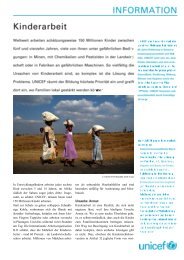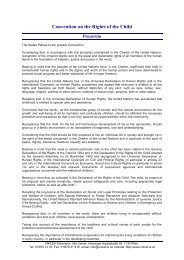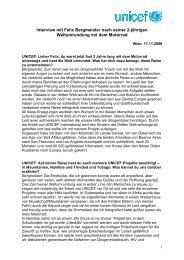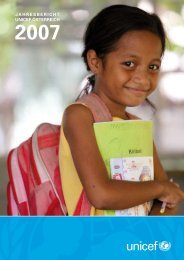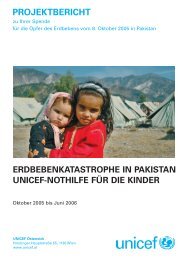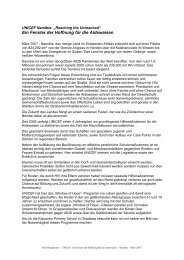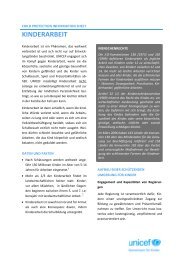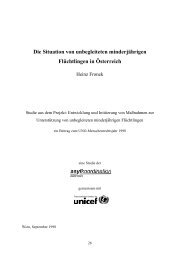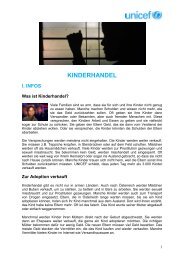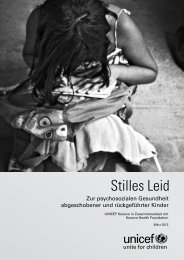Child Trafficking in Europe
Child Trafficking in Europe
Child Trafficking in Europe
You also want an ePaper? Increase the reach of your titles
YUMPU automatically turns print PDFs into web optimized ePapers that Google loves.
person or group of persons to another for remunera-<br />
tion or any other consideration.” Article 2(b) def<strong>in</strong>es<br />
child prostitution as “the use of a child <strong>in</strong> sexual<br />
activities for remuneration or any other form of con-<br />
sideration.” Article 2(c) specifies that child pornography<br />
means “any representation, by whatever means, of<br />
a child engaged <strong>in</strong> real or simulated explicit sexual<br />
activities or any representation of the sexual parts of<br />
a child for primarily sexual purposes.”<br />
The Optional Protocol requires States, at a m<strong>in</strong>imum,<br />
to crim<strong>in</strong>alize the sale of children, child prostitution<br />
and pornography whether committed domestically or<br />
transnationally (article 3). In the context of the ‘sale<br />
of children,’ the scope of the Optional Protocol goes<br />
beyond the purpose of sexual exploitation. It mentions<br />
specifically “offer<strong>in</strong>g, deliver<strong>in</strong>g or accept<strong>in</strong>g, by what-<br />
ever means, a child for the purpose of sexual exploitation<br />
of the child;...transfer of organs of the child for<br />
profit;...engagement of the child <strong>in</strong> forced labour;<br />
...improperly <strong>in</strong>duc<strong>in</strong>g consent, as an <strong>in</strong>termediary, for<br />
the adoption of a child <strong>in</strong> violation of applicable <strong>in</strong>ter-<br />
national legal <strong>in</strong>struments on adoption.” (Article 3.)<br />
‘palermo protocol’<br />
The Protocol to Prevent, Suppress and Punish <strong>Traffick<strong>in</strong>g</strong><br />
<strong>in</strong> Persons, Especially Women and <strong>Child</strong>ren, supplement<strong>in</strong>g<br />
the United Nations Convention aga<strong>in</strong>st Transnational<br />
Organized Crime, also known as the ‘Palermo<br />
Protocol’, is the first legal <strong>in</strong>strument to provide an<br />
<strong>in</strong>ternationally agreed on def<strong>in</strong>ition of traffick<strong>in</strong>g <strong>in</strong><br />
human be<strong>in</strong>gs and child traffick<strong>in</strong>g. 37<br />
Adopted <strong>in</strong> 2000, the Palermo Protocol def<strong>in</strong>es traffick<strong>in</strong>g<br />
<strong>in</strong> human be<strong>in</strong>gs as “the recruitment, transportation,<br />
transfer, harbour<strong>in</strong>g or receipt of persons,<br />
by means of the threat or use of force or other forms<br />
of coercion, of abduction, of fraud, of deception, of<br />
the abuse of power or of a position of vulnerability<br />
or the giv<strong>in</strong>g or receiv<strong>in</strong>g of payments or benefits<br />
to achieve the consent of a person hav<strong>in</strong>g control<br />
over another person, for the purpose of exploitation.<br />
Exploitation shall <strong>in</strong>clude, at a m<strong>in</strong>imum, the exploitation<br />
of the prostitution of others or other forms of<br />
sexual exploitation, forced labour or services, slavery<br />
or practices similar to slavery, servitude or the removal<br />
of organs.” (Article 3 (a).)<br />
On child traffick<strong>in</strong>g, the Palermo Protocol is clear that<br />
no violence, deception or coercion is required; it is<br />
sufficient to know that a person under 18 years of age<br />
has been recruited and moved for the purpose of exploitation<br />
for that person to be considered a victim of<br />
traffick<strong>in</strong>g. Article 3(c) states: “The recruitment, transportation,<br />
transfer, harbour<strong>in</strong>g or receipt of a child for<br />
the purpose of exploitation shall be considered ‘traffick<strong>in</strong>g<br />
<strong>in</strong> persons’ even if this does not <strong>in</strong>volve any of<br />
the means set forth <strong>in</strong> subparagraph (a) of this article.”<br />
This def<strong>in</strong>ition implies the understand<strong>in</strong>g that a child<br />
cannot consent to be<strong>in</strong>g trafficked and a child’s<br />
‘consent’ is not recognized as a justification for any<br />
form of child exploitation or abuse.<br />
The Palermo Protocol is <strong>in</strong>tended “to prevent and com-<br />
bat traffick<strong>in</strong>g <strong>in</strong> persons, especially women and<br />
children” through “a comprehensive <strong>in</strong>ternational<br />
approach <strong>in</strong> the countries of orig<strong>in</strong>, transit and dest<strong>in</strong>ation<br />
that <strong>in</strong>cludes measures to prevent such traffick<strong>in</strong>g,<br />
to punish the traffickers and to protect the<br />
victims.” 38 One of its stated purposes is to “protect<br />
and assist the victims...of traffick<strong>in</strong>g, with full respect<br />
for their human rights.” 39 Articles 9(a) and 9(b) require<br />
States parties to establish comprehensive policies<br />
that specifically prevent children from revictimization.<br />
The Palermo Protocol focuses much more on aspects<br />
of crim<strong>in</strong>al law than on the protection of victims. 40 It<br />
emphasizes border control and security of documents,<br />
while vague language is used on the types of measures<br />
that States must “endeavour to undertake” to assist trafficked<br />
persons. 41 In order to protect the human rights<br />
of trafficked children, the Palermo Protocol should be<br />
applied along with other <strong>in</strong>ternational standards, <strong>in</strong><br />
particular the Convention on the Rights of the <strong>Child</strong><br />
and its Optional Protocols. 42<br />
The CRC Optional Protocol on the Sale of <strong>Child</strong>ren,<br />
<strong>Child</strong> Prostitution and <strong>Child</strong> Pornography conta<strong>in</strong>s<br />
more explicit measures to protect the rights and<br />
<strong>in</strong>terests of child victims. Its provisions are mandatory.<br />
Both protocols complement one another, each<br />
approach<strong>in</strong>g the issue of child traffick<strong>in</strong>g and child<br />
exploitation from a different perspective. Ratification<br />
and implementation of both <strong>in</strong>struments is therefore<br />
essential to provide broad protection for children<br />
who have been trafficked or sold <strong>in</strong>to exploitation.<br />
As of 8 November 2007, 37 countries had ratified the<br />
CRC Optional Protocol, and 42 <strong>Europe</strong>an countries<br />
and the <strong>Europe</strong>an Community had ratified the Palermo<br />
Protocol. Only 35 <strong>Europe</strong>an countries have ratified<br />
both the Palermo Protocol and the CRC Optional<br />
Protocol. Both protocols have been ratified <strong>in</strong> more<br />
than half of the countries <strong>in</strong> the subregion <strong>Europe</strong>an<br />
Union and other Western <strong>Europe</strong>an countries and <strong>in</strong><br />
eight countries <strong>in</strong> CIS. In South Eastern <strong>Europe</strong>, n<strong>in</strong>e<br />
countries have ratified both Protocols.<br />
The process of ratification varies from one subregion<br />
to another. In the <strong>Europe</strong>an Union and other Western<br />
<strong>Europe</strong>an countries, it is more usual to sign <strong>in</strong>ternational<br />
legal <strong>in</strong>struments soon after their adoption,<br />
with some years often pass<strong>in</strong>g before conclusion of<br />
the national process of ratification. In South Eastern<br />
<strong>Europe</strong> and CIS, the signature is more often delayed<br />
but the ratification process is completed quickly.<br />
Legislation on child traffick<strong>in</strong>g 17



